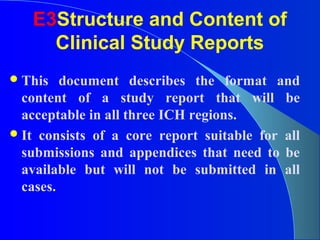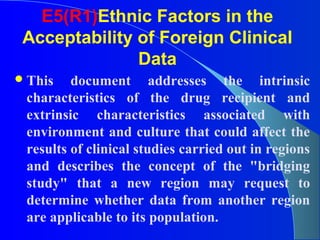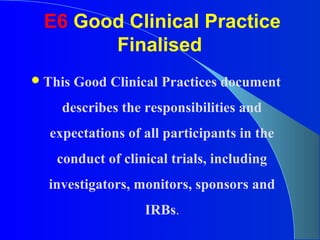Pharmacovigilance and ICH guidlines
- 1. PHARMACOVIGILANCEPHARMACOVIGILANCE & ICH GUIDELINES& ICH GUIDELINES Prepared by Mr.C.STALIN.M.Pharm.,(Ph.D) Technical Associate, Adverse events Monitoring Centre, Govt Kilpauk Medical college, Chennai.
- 2. What is Pharmacovigilance??What is Pharmacovigilance?? ’ü¼Data gathering related to the detection, assessment, understanding, and prevention of adverse events. ’ü¼Identifying new information about hazards associated with medicines, preventing harm to patients.
- 3. TermsTerms ’ü¼Adverse Event (AE) ŌĆō any untoward medical occurrence that may present during treatment with a pharmaceutical product but which does not necessarily have a casual relationship with this treatment. ’ü¼Adverse Drug Reaction (ADR) ŌĆō a response to a drug which is noxious and unintended, and which occurs at doses normally used in man. ’ü¼Serious Adverse Event (SAE) ŌĆō AE that is either life-threatening, fatal, cause of prolong hospital admission, cause persistent disability or concern misuse or dependence.
- 4. E1 Clinical Safety for Drugs used in Long-Term Treatment ’ü¼The Extent of Population Exposure to Assess Clinical Safety for Drugs Intended for Long- Term Treatment of Non-Life Threatening Conditions. ’ü¼This document gives recommendations on the numbers of patients and duration of exposure for the safety evaluation of drugs intended for the long-term treatment of non-life- threatening conditions.
- 5. E2A-Clinical Safety Data Management: Definitions and Standards for Expedited Reporting ’ü¼This document gives standard definitions and terminology for key aspects of clinical safety reporting. ’ü¼It also gives guidance on mechanisms for handling expedited (rapid) reporting of adverse drug reactions in the investigational phase of drug development.
- 6. E2B(R3)Clinical Safety Data Management: Data Elements for Transmission of Individual Case Safety Reports ’ü¼The ICH Steering Committee had taken a key decision that technical specifications should no longer be developed solely within ICH, but should be created in collaboration with Standards Development Organisations (SDOs) to enable wider inter-operability across the regulatory and healthcare communities.
- 7. E2B(R3) IWG Implementation: Electronic Transmission of Individual Case Safety Reports ’ü¼In July 2013, the ICH Steering Committee endorsed the establishment of the IWG on E2B(R3) to assist with the implementation of the E2B(R3) Implementation Guide (published in July 2013) and help facilitate transition from E2B(R2) to E2B(R3).
- 8. E2C(R2)Periodic Benefit-Risk Evaluation ReportE2C, E2CA ’ü¼This document gives guidance on the format and content of safety updates, which need to be provided at intervals to regulatory authorities after products have been marketed.
- 9. E2D Post-Approval Safety Data Management: Definitions and Standards for Expedited Reporting ’ü¼This document provides a standardised procedure for post-approval safety data management including expedited reporting to relevant authority. The definitions of the terms and concept specific to post-approval phase are also provided. ’ü¼E2A definitions in clinical safety data management was maintained in this document as post-approval safety data management, such as seriousness definition.
- 10. E2EPharmacovigilance Planning ’ü¼This was intended to aid in planning Pharmacovigilance activities, especially in preparation for the early postmarketing period of a new drug . ’ü¼The main focus of this Guideline is on a Safety Specification and Pharmacovigilance Plan that might be submitted at the time of licence application.
- 11. E2F Development Safety Update Report ’ü¼The main focus of the DSUR is data from interventional clinical trials (referred to in this document as "clinical trials") of investigational drugs including biologicals, with or without a marketing approval, whether conducted by commercial or non- commercial sponsors.
- 12. E3Structure and Content of Clinical Study Reports ’ü¼This document describes the format and content of a study report that will be acceptable in all three ICH regions. ’ü¼It consists of a core report suitable for all submissions and appendices that need to be available but will not be submitted in all cases.
- 13. E4Dose-Response Information to Support Drug Registration ’ü¼This document gives recommendations on the design and conduct of studies to assess the relationship between doses, blood levels and clinical response throughout the clinical development of a new drug.
- 14. E5(R1)Ethnic Factors in the Acceptability of Foreign Clinical Data ’ü¼This document addresses the intrinsic characteristics of the drug recipient and extrinsic characteristics associated with environment and culture that could affect the results of clinical studies carried out in regions and describes the concept of the "bridging study" that a new region may request to determine whether data from another region are applicable to its population.
- 15. E6 Good Clinical Practice Finalised ’ü¼This Good Clinical Practices document describes the responsibilities and expectations of all participants in the conduct of clinical trials, including investigators, monitors, sponsors and IRBs.
- 16. E6 Good Clinical Practice Finalised ’ü¼GCPs cover aspects of monitoring, reporting and archiving of clinical trials and incorporating addenda on the Essential Documents and on the Investigator's Brochure which had been agreed earlier through the ICH process.
- 17. E7Studies in Support of Special Populations ’ü¼This document provides recommendations on the special considerations which apply in the design and conduct of clinical trials of medicines that are likely to have significant use in the elderly.
- 18. E8General Considerations for Clinical Trials Finalised Guideline ’ü¼This document sets out the general scientific principles for the conduct, performance and control of clinical trials. The Guideline addresses a wide range of subjects in the design and execution of clinical trials.
- 19. E9 Statistical Principles for Clinical Trials ’ü¼This Bio statistical Guideline describes essential considerations on the design and analysis of clinical trials, especially the "confirmatory" (hypothesis-testing) trials that are the basis for demonstrating effectiveness.
- 20. E10 Choice of Control Group and Related Issues in Clinical Trials ’ü¼This document addresses the choice of control groups in clinical trials considering the ethical and inferential properties and limitations of different kinds of control groups. ’ü¼ It points out the assay sensitivity problem in active control equivalence / non-inferiority trials that limits the usefulness of trial design in many circumstances.
- 21. E11Clinical Investigation of Medicinal Products in the Pediatric Population ’ü¼This document addresses the conduct of clinical trials of medicines in pediatric populations. This document will facilitate the development of safe and effective use of medicinal product in pediatrics.
- 22. E12Principles for Clinical Evaluation of New Antihypertensive Drugs ’ü¼This therapeutic area document considers the Clinical Evaluation of New Antihypertensive Drugs. It provides a set of "Principles" on which there is general agreement among all three ICH regions covering endpoints and trial designs.
- 23. E12Principles for Clinical Evaluation of New Antihypertensive Drugs ’ü¼Since there are a few differences in the requirements of the three regions that have not been harmonised, this document should be considered an "ICH Principle Document" rather than an "ICH Guideline".
- 24. E14The Clinical Evaluation of QT/QTc Interval Prolongation and Proarrhythmic Potential for Non- Antiarrhythmic Drugs ’ü¼ This document provides recommendations to sponsors concerning the design, conduct, analysis, and interpretation of clinical studies to assess the potential of a drug to delay cardiac repolarisation.
- 25. E15 Definitions for Genomic Biomarkers, Pharmacogenomics, Pharmacogenetics, Genomic Data and Sample Coding Categories ’ü¼This Guideline contains definitions of key terms in the discipline of pharmacogenomics and pharmacogenetics, namely genomic biomarkers, pharmacogenomics, pharmacogenetics and genomic data and sample coding categories.
- 26. E16 Biomarkers Related to Drug or Biotechnology Product Development: Context, Structure and Format of Qualification Submissions ’ü¼The Guideline describes recommendations regarding context, structure, and format of regulatory submissions for qualification of genomic biomarkers, as defined in ICH E15.
- 27. E17General principle on planning/designing Multi- Regional Clinical Trials ’ü¼This new guidance is proposed to provide guidance on general principles on planning/designing Multi-Regional Clinical Trial (MRCT).
- 28. E18Genomic Sampling Methodologies for Future Use ’ü¼This new guidance is proposed to provide guidance on genomic sample collection to evaluate efficacy and safety of a drug for regulatory approval.
- 29. Thank you!!!!




























